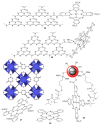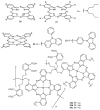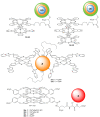Phthalocyanines: An Old Dog Can Still Have New (Photo)Tricks!
- PMID: 34068708
- PMCID: PMC8126243
- DOI: 10.3390/molecules26092823
Phthalocyanines: An Old Dog Can Still Have New (Photo)Tricks!
Abstract
Phthalocyanines have enjoyed throughout the years the benefits of being exquisite compounds with many favorable properties arising from the straightforward and diverse possibilities of their structural modulation. Last decades appreciated a steady growth in applications for phthalocyanines, particularly those dependent on their great photophysical properties, now used in several cutting-edge technologies, particularly in photonic applications. Judging by the vivid reports currently provided by many researchers around the world, the spotlight remains assured. This review deals with the use of phthalocyanine molecules in innovative materials in photo-applications. Beyond a comprehensive view on the recent discoveries, a critical review of the most acclaimed/considered reports is the driving force, providing a brief and direct insight on the latest milestones in phthalocyanine photonic-based science.
Keywords: charge transfer; nonlinear optics; photocatalysis; photoelectronics; photonics; photovoltaics; phthalocyanine.
Conflict of interest statement
The authors declare no conflict of interest. The funders had no role in the design of the study; in the collection, analyses, or interpretation of data; in the writing of the manuscript; or in the decision to publish the results.
Figures
















Similar articles
-
Phthalocyanines: from outstanding electronic properties to emerging applications.Chem Rec. 2008;8(2):75-97. doi: 10.1002/tcr.20139. Chem Rec. 2008. PMID: 18366105
-
Graphene and Carbon-Nanotube Nanohybrids Covalently Functionalized by Porphyrins and Phthalocyanines for Optoelectronic Properties.Adv Mater. 2018 Apr;30(17):e1705704. doi: 10.1002/adma.201705704. Epub 2018 Feb 16. Adv Mater. 2018. PMID: 29450914 Review.
-
Self-assembling porphyrins and phthalocyanines for photoinduced charge separation and charge transport.Chem Commun (Camb). 2012 Apr 28;48(34):4032-45. doi: 10.1039/c2cc30621b. Epub 2012 Mar 19. Chem Commun (Camb). 2012. PMID: 22430327
-
Optical-limiting and photophysical properties of two soluble chloroindium phthalocyanines with alpha- and beta-alkoxyl substituents.Chemphyschem. 2006 Apr 10;7(4):935-41. doi: 10.1002/cphc.200500595. Chemphyschem. 2006. PMID: 16526074
-
Innovative Design Strategies Advance Biomedical Applications of Phthalocyanines.Adv Healthc Mater. 2023 Sep;12(22):e2300263. doi: 10.1002/adhm.202300263. Epub 2023 May 16. Adv Healthc Mater. 2023. PMID: 37039069 Review.
Cited by
-
Macrocyclic Compounds: Metal Oxide Particles Nanocomposite Thin Films Deposited by MAPLE.Materials (Basel). 2023 Mar 21;16(6):2480. doi: 10.3390/ma16062480. Materials (Basel). 2023. PMID: 36984360 Free PMC article.
-
Polypropylene Color Masterbatches Containing Layered Double Hydroxide Modified with Quinacridone and Phthalocyanine Pigments-Rheological, Thermal and Application Properties.Materials (Basel). 2023 Sep 16;16(18):6243. doi: 10.3390/ma16186243. Materials (Basel). 2023. PMID: 37763521 Free PMC article.
-
Synthesis and Dynamic Behavior of Ce(IV) Double-Decker Complexes of Sterically Hindered Phthalocyanines.Molecules. 2024 Feb 17;29(4):888. doi: 10.3390/molecules29040888. Molecules. 2024. PMID: 38398640 Free PMC article.
-
Prion Strains Differ in Susceptibility to Photodynamic Oxidation.Molecules. 2022 Jan 18;27(3):611. doi: 10.3390/molecules27030611. Molecules. 2022. PMID: 35163872 Free PMC article.
-
Dual Emissive Zn(II) Naphthalocyanines: Synthesis, Structural and Photophysical Characterization with Theory-Supported Insights towards Soluble Coordination Compounds with Visible and Near-Infrared Emission.Int J Mol Sci. 2024 Feb 23;25(5):2605. doi: 10.3390/ijms25052605. Int J Mol Sci. 2024. PMID: 38473852 Free PMC article.
References
-
- Dini D., Hanack M. Physical Properties of Phthalocyanine-based Materials. In: Kadish K.M., Guilard R., Smith K.M., editors. The Porphyrin Handbook, Phthalocyanines: Properties and Materials. Volume 17. Academic Press; San Diego, CA, USA: 2003. pp. 1–36.
-
- L’Her M., Pondaven A. Electrochemistry of Phthalocyanines. In: Kadish K.M., Guilard R., Smith K.M., editors. The Porphyrin Handbook, Phthalocyanines: Spectroscopic and Electrochemical Characterization. Volume 16. Academic Press; San Diego, CA, USA: 2003. pp. 117–170.
-
- Nyokong T., Antunes E. Photochemical and Photophysical Properties of Metallophthalocyanines. In: Kadish K.M., Smith K.M., Guilard R., editors. Handbook of Porphyrin Science, with Applications to Chemistry, Physics, Materials Science, Engineering, Biology and Medicine. Volume 7. World Scientific Publishing; Singapore: 2012. pp. 247–358.
-
- Fukuda T., Kobayashi N. UV-Visible Absorption Spectroscopic Properties of Phthalocyanines and Related Macrocycles. In: Kadish K.M., Smith K.M., Guilard R., editors. Handbook of Porphyrin Science, with Applications to Chemistry, Physics, Materials Science, Engineering, Biology and Medicine. Volume 9. World Scientific Publishing; Singapore: 2012. pp. 1–642.
-
- Calvete M.J.F. Future Trends for Top Materials. Bentham Science; Sarjah, United Arab Emirates: 2016. Phthalocyanines as top materials; pp. 3–77.
Publication types
Grants and funding
LinkOut - more resources
Full Text Sources

